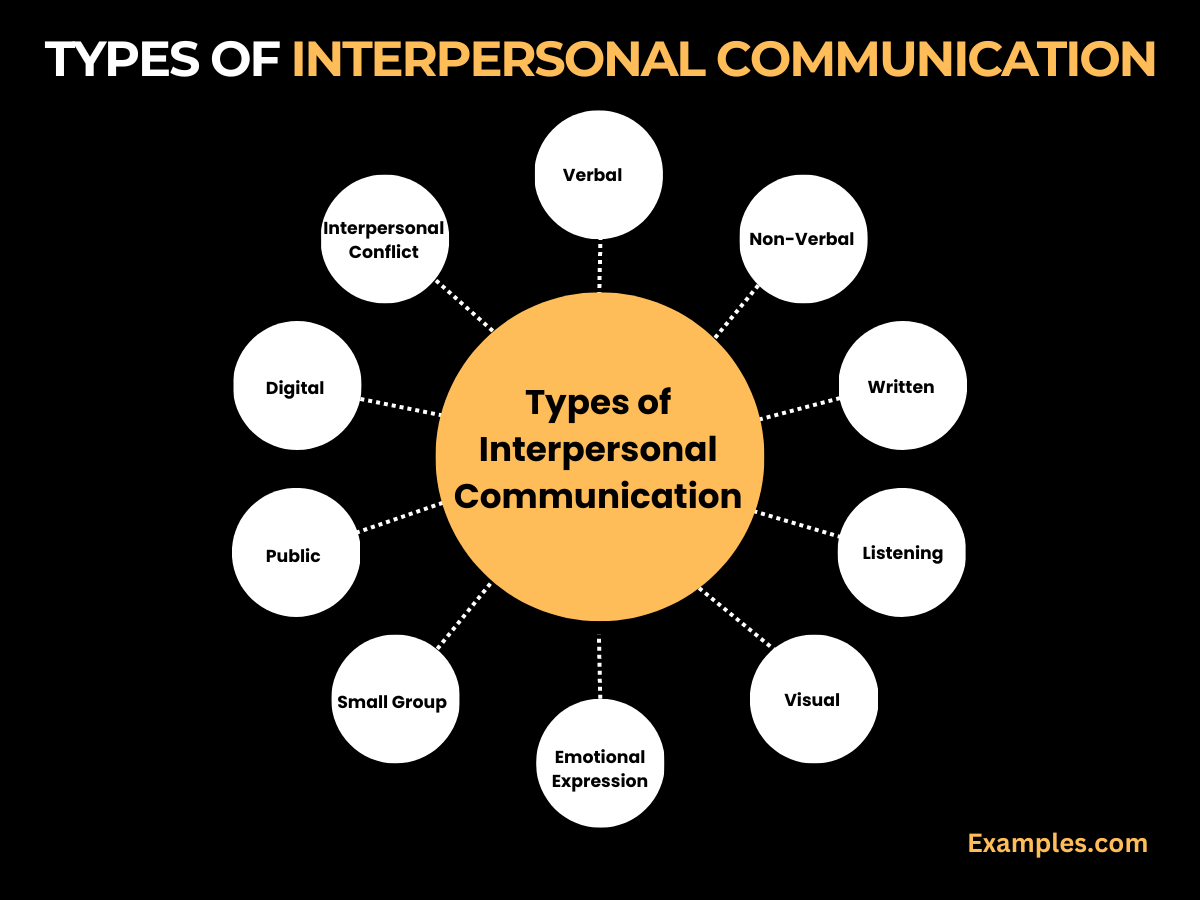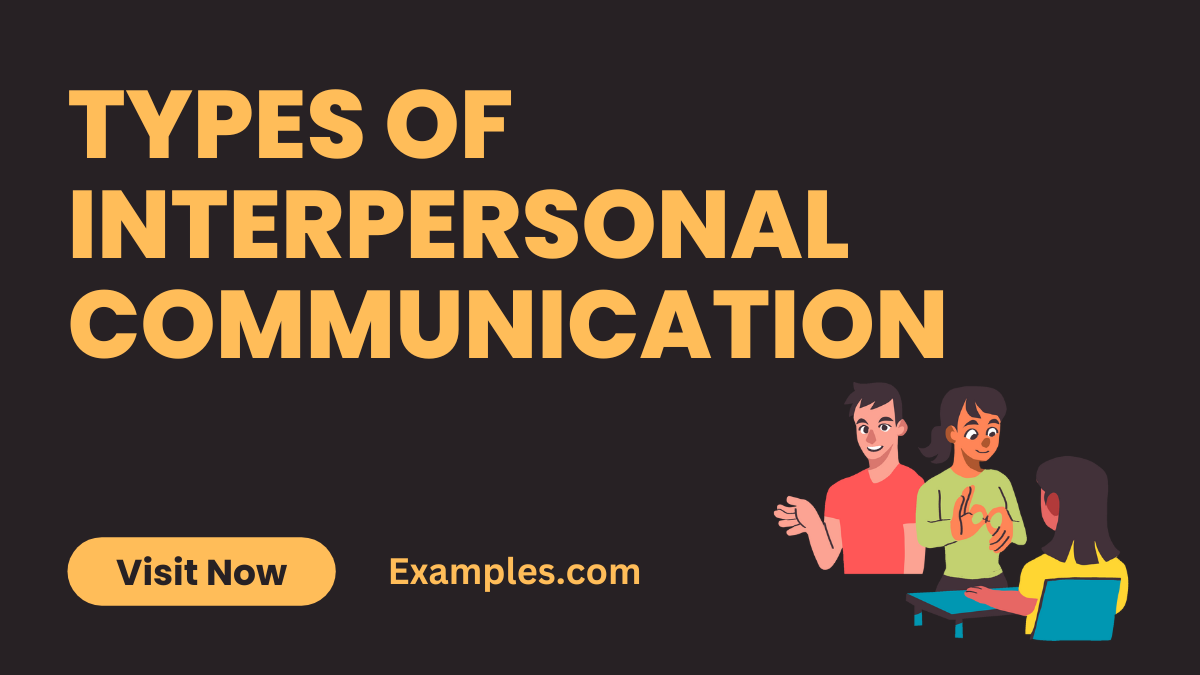Types of Interpersonal Communication – Examples, Types
Interpersonal communication encompasses various forms that are integral to our daily interactions and relationships. This guide delves into the diverse types of interpersonal communication, ranging from verbal exchanges that articulate our thoughts and feelings to non-verbal cues that subtly convey emotions and intentions. We’ll explore the nuanced realms of written communication, where words bridge distances, and listening, the silent yet powerful aspect of interaction. Our journey will also cover visual communication, the impactful use of images and symbols, and the critical role of emotional expression in building connections. With practical examples and insightful tips, this comprehensive guide is your key to understanding and mastering the art of interpersonal communication in all its forms.
Types of Interpersonal Communication

Verbal Communication
Verbal communication in interpersonal settings involves the use of spoken words to convey messages. It encompasses various elements, including language, tone, and pitch, which play a crucial role in expressing ideas and emotions. Verbal communication is fundamental in Interpersonal Communication Examples and Types of Interpersonal Communication. Effective verbal communication requires clarity, conciseness, and the ability to listen actively. It’s instrumental in building relationships, solving problems, and in decision-making processes. The impact of verbal communication in interpersonal communication is profound, as it enables individuals to share their thoughts and feelings directly and responsively.
Example: “Could you please explain this further?” demonstrates clarity in verbal communication.
Non-Verbal Communication
Non-verbal communication involves the transmission of messages without the use of words. This form of communication includes body language, facial expressions, gestures, posture, and eye contact. In Interpersonal Communication, non-verbal cues often complement or contradict what’s being said verbally. They play a critical role in conveying emotions and attitudes, such as trust, aggression, or submission. Understanding and interpreting non-verbal signals accurately in Interpersonal Communication Situations enhances the effectiveness of interaction, as these cues often reveal more than spoken words.
Example: Nodding while listening indicates active engagement without words.
Written Communication
Written communication in interpersonal contexts involves the exchange of messages through written symbols, like letters, emails, texts, or social media posts. It is essential for documenting and conveying complex information clearly and precisely. In Interpersonal Communication, written communication offers the advantage of thoughtfulness and permanence. However, it lacks the immediacy and emotional cues of verbal and non-verbal communication. Effective written communication in Interpersonal Communication Settings requires good grammar, clarity, and appropriate tone, catering to the audience’s needs and context.
Example: A well-crafted email can convey respect and clarity.
Listening Communication
Listening is a vital component of effective interpersonal communication. It involves actively paying attention to the speaker, understanding their message, and responding appropriately. Effective listening in Interpersonal Communication is not just about hearing words but also about comprehending the emotions and intentions behind them. It plays a crucial role in Emotional Expression in Interpersonal Communication, as it helps to build empathy and understanding. Good listeners are able to provide feedback that indicates they have accurately interpreted the message, enhancing mutual understanding and trust.
Example: “I understand your point, can you elaborate?” shows attentive listening.
Visual Communication
Visual communication in interpersonal contexts refers to the conveyance of ideas and information in forms that can be seen, such as signs, drawings, graphics, and other visual aids. It complements verbal and non-verbal communication by providing additional context and can be particularly effective in Interpersonal Communication Situations where verbal communication is not possible or practical. Visual aids in Interpersonal Communication help to reinforce verbal communication, making complex ideas more understandable and memorable. Effective visual communication requires consideration of aesthetics, clarity, and relevance to the audience.
Example: A well-organized presentation aids in clear visual communication.
Emotional Expression
Emotional expression is a pivotal aspect of interpersonal communication. It involves conveying feelings and emotions through various forms, including verbal and non-verbal cues. Emotional expression is not just about sharing how one feels but also about understanding the emotions of others, thus facilitating a deeper connection. It’s an integral part of effective communication as it helps in building trust and empathy within relationships. Emotional intelligence plays a crucial role in managing and expressing emotions constructively. Mastery in emotional expression can enhance both personal and professional interactions, making it a vital skill in interpersonal dynamics.
Example: Saying “I’m really happy with your work” expresses positive emotions.
Small Group Communication
Small group communication refers to interactions among a small number of people working towards a common goal or sharing a common interest. This form of communication is crucial in various settings like workplaces, educational institutions, and social gatherings. It involves sharing ideas, decision-making, problem-solving, and support. Effective small group communication requires skills like active listening, constructive feedback, and conflict resolution. It also often involves elements of verbal and non-verbal communication. Small group dynamics significantly impact the outcome of discussions and decisions, highlighting the importance of good communication skills in these settings.
Example: “Let’s all share our ideas” fosters inclusive small group communication.
Public Communication
Public communication is a branch of interpersonal communication where an individual or a group conveys information to a larger audience. This form of communication is essential in various fields like politics, education, and business. It involves skills such as clear articulation, engaging storytelling, and audience awareness. Public communication is not just about delivering information; it’s about connecting with the audience at a deeper level to inspire, inform, or persuade. Mastery in public communication can have a significant impact on one’s ability to influence and lead. It often integrates listening skills and verbal communication strategies to be effective.
Example: A public speech that engages the audience demonstrates effective public communication.
Digital Communication
Digital communication has become an integral part of interpersonal interactions in the modern world. It encompasses various forms such as emails, social media, texting, and video conferencing. Digital platforms offer convenience and a broad reach but also present challenges like misinterpretation and lack of personal touch. Effective digital communication requires clarity, conciseness, and an understanding of digital etiquette. It plays a crucial role in maintaining relationships and conducting business in today’s globalized environment. In this digital age, adapting interpersonal communication skills to virtual platforms is essential.
Example: Timely responses on social media are part of effective digital communication.
Interpersonal Conflict Communication
Interpersonal conflict communication deals with how individuals communicate in situations of disagreement or discord. It’s an inevitable aspect of all relationships, whether personal or professional. Effective conflict communication involves skills such as active listening, empathy, assertiveness, and negotiation. It aims to resolve differences constructively without damaging relationships. Understanding and managing emotions play a key role in conflict communication. The goal is to reach a solution that is acceptable to all parties involved, making it a critical component of healthy interpersonal interactions.
Example: “I see your point, but have you considered this…?” aids in conflict resolution.
In conclusion, mastering the various types of interpersonal communication is crucial for personal growth and professional success. Each form, from verbal and non-verbal to digital and public communication, offers unique opportunities for conveying and receiving messages effectively. As we navigate through different communication scenarios, understanding the nuances of each type helps in building stronger, more meaningful relationships. For further insights into enhancing your interpersonal communication skills, explore this resource from the University of Minnesota which delves into conflict management styles, a vital aspect of interpersonal communication. Additionally, the Professional Development and Training section of Portland Community College offers valuable information on the benefits of effective communication in various settings, highlighting the impact of good communication skills on productivity, trust-building, and relationship enhancement in both personal and professional realms. These resources provide comprehensive guidance and strategies to refine your communication skills, thereby contributing significantly to your interpersonal communication journey.



